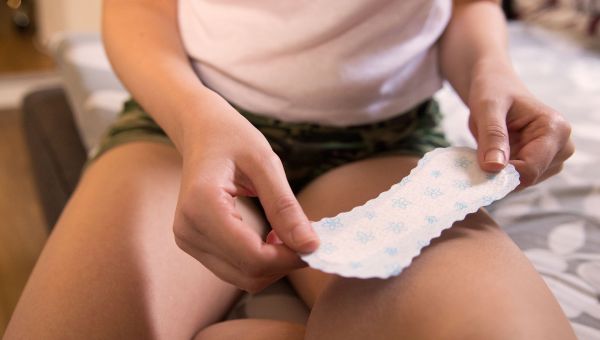7 Types of Vaginal Discharge
From menstrual cycles and pregnancy to STIs, learn about typical vaginal discharge and when you should see a healthcare provider.
Updated on July 25, 2023

Vaginal discharge is typically a natural bodily function, especially during certain life experiences such as pregnancy and menopause.
In fact, many of the fluids in your vagina are there to protect you: Healthy discharge includes vaginal skin cells, bacteria, mucus and fluid that come from the vagina and the cervix, which is the narrow opening of the uterus. This fluid guards against vaginal and urinary tract infections (UTIs) and helps lubricate vaginal tissues.
But discharge can also be a sign of an underlying health issue. If something doesn’t look, feel or smell right, it’s best to see your healthcare provider (HCP), says women’s health specialist Jackie Moore, DNP, WHNP-BC, of Women’s Health Partners and Summerville Medical Center in South Carolina. Here’s what to know about how vaginal discharge should look, when it might change, and when to see a healthcare provider (HCP).

Typical Discharge During Your Menstrual Cycle
After menstrual bleeding stops, your vaginal discharge returns to a mucus-like white consistency; it may become heavier after strenuous activities like exercising. Then, around mid-ovulation, the discharge will change to a clearer color and look like egg whites. The consistency of this discharge will be stretchy and can sometimes drip into the toilet, says Moore. "This discharge is perfectly normal—it's nature's way of allowing for pregnancy.”

Changes During Pregnancy
During pregnancy, hormone levels are constantly changing, and that affects vaginal discharge. “You’re going to have thin, white mucousy discharge that smells mild at times,” says Moore. Pregnancy-specific discharge is called leukorrhea, and it isn’t usually a cause for concern. If you’re bothered by the discharge, wear a panty liner or pad to help soak it up.
However, if you’re pregnant and you have discharge that is green or yellow, smells strongly or is accompanied by itching, see your HCP. You may have a vaginal infection.
During pregnancy, discharge can be accompanied by spotting (light bleeding), especially during the first 20 weeks of gestation. While spotting can be typical, heavy bleeding is not. If you’re pregnant, tell your HCP about any bleeding—especially if it progresses to heavy bleeding that fills a pad and if you have cramping or pain, as well.

Postpartum Changes
After giving birth, it’s typical to have some bleeding for up to six weeks postpartum, depending on whether you had a vaginal birth or c-section delivery. The discharge will probably start off looking red, but will go through a series of color changes—pink, then yellow or white. You may also pass some small blood clots right after birth, too.
Menstruation often returns four to nine weeks after delivery if you’re not breastfeeding, and 3 to 12 months or longer after delivery if you're breastfeeding. When it does, your hormone levels will start to regularize. “Your estrogen and progesterone levels revert back to how they were before, so you may notice your discharge returning back to usual, too,” says Moore.
If you go on certain birth control methods, you may notice an increase in discharge. “The vaginal estrogen and progesterone birth control ring as well as regular birth control pills are great contraception options, but one of the side effects is an increase in typical discharge,” says Moore. On the flip side, other progestin-only birth control methods like pills and implants may actually reduce your discharge.

Changes During Perimenopause or Menopause
For many people, going through the menopause transition will actually decrease the amount of discharge you experience, says Moore, who explains that as estrogen levels drop, the vaginal lining gets thinner and drier, leading to the production of less fluid.
However, up to 40 percent of people who are postmenopausal may experience genitourinary syndrome of menopause (GSM), or inflammation of the vagina. It's caused by lower levels of estrogen, plus increased pH levels. Symptoms include leaky discharge, pain during sex, irritation and burning. To treat the condition, many HCPs recommend vaginal estrogen treatment in the form of a cream, tablet or ring. Vaginal dryness can also increase your risk for infections. If you notice a change in the color or odor of your discharge, see your HCP to see if you may need treatment.

Changes During Sexual Arousal
During sexual arousal, moisture lubricates your vagina, preparing it for intercourse—it’s one of the biological functions that makes sex feel good.
Here's how it works: when you’re stimulated, such as with a partner, during masturbation, or even just watching a sexy movie, your genital tissues start to fill with blood, which causes your clitoris, vaginal opening and inner and outer lips to feel swollen. The swelling and increased blood flow help produce a fluid that makes the vaginal lips wet.
When you orgasm, you may have a mucous-like discharge. “During intercourse, all of the glands are moist so there’s an increase in lubrication," says Moore. Some people may actually squirt, or ejaculate, clear fluid that is released from their glands.

Changes Caused By Bacterial Vaginosis
Bacterial vaginosis (BV) is an infection that occurs when bacterial growth in the vagina becomes out of balance. Symptoms can include a thin white or gray discharge, vaginal pain, burning and a fish-like odor. The infection mostly affects people who are sexually active, though douching can also cause BV. While researchers aren’t completely sure why there’s a connection between douching and BV, gynecologists generally advise that douching is unnecessary and recommend skipping it.
Leaving BV untreated can increase your risk of HIV, pelvic inflammatory disease and sexually transmitted illnesses such as chlamydia and gonorrhea. BV is treated with prescription antibiotics, which can be taken orally or inserted into the vagina.

Changes Caused By A Yeast Infection
A vaginal yeast infection occurs when there is an overgrowth of yeast called Candida. The classic sign of a yeast infection is a thick, white, cottage cheese-like discharge along with vaginal itching and burning. Antifungal creams or pills prescribed by your HCP can clear up the infection in one to seven days. Over-the-counter creams can be highly effective, too.

When To See Your HCP
Any time you experience discharge that looks, smells, or feels different than typical vaginal fluids, get it checked out. Sometimes sexually transmitted infections like chlamydia, gonorrhea and trichomoniasis may not cause any symptoms other than discharge.
“If your discharge is green, yellow or has a very pungent odor and you have other symptoms like pelvic pain or trouble urinating, you definitely need to see your gyno,” says Moore.
Moore suggests taking note of how you notice the discharge, too. “If it’s mustardy or green when you wipe, it may be an infection," she says. "If you have white discharge that dries and turns slightly yellow on your underwear, that’s okay.”

American Pregnancy Association. Cervical Mucus and Early Pregnancy. Accessed December 15, 2022.
American Pregnancy Association. Vaginal Discharge During Pregnancy. Accessed December 15, 2022.
Spence D, Melville C. Vaginal discharge. BMJ. 2007;335(7630):1147-1151.
Khaskheli M, Baloch S, et al. Vaginal discharge during pregnancy and associated adverse maternal and perinatal outcomes. Pak J Med Sci. 2021;37(5):1302-1308.
MedlinePlus. Vaginal delivery – discharge. Reviewed October 5, 2020.
North American Menopause Society. Changes in the Vagina and Vulva. Accessed December 15, 2022.
Angelou K, Grigoriadis T, et al. The Genitourinary Syndrome of Menopause: An Overview of the Recent Data. Cureus. 2020;12(4):e7586. Published 2020 Apr 8.
Moral E, Delgado JL, Carmona F, et al. Genitourinary syndrome of menopause. Prevalence and quality of life in Spanish postmenopausal women. The GENISSE study. Climacteric. 2018;21:167–173.
American College of Obstetricians and Gynecologists. Treatment of Urogenital Symptoms in Individuals With a History of Estrogen-dependent Breast Cancer. December 2021.
Go Ask Alice. Vaginal discharge vs. lube from being turned on? Last updated March 4, 2014.
Sexwise (UK). Sexual Pleasure. Last updated February 2018.
Centers for Disease Control and Prevention. Bacterial Vaginosis – CDC Basic Fact Sheet. Page last reviewed January 5, 2022.
Joseph RJ, Ser HL, et al. Finding a Balance in the Vaginal Microbiome: How Do We Treat and Prevent the Occurrence of Bacterial Vaginosis? Antibiotics (Basel). 2021;10(6):719. Published 2021 Jun 15.
WomensHealth.gov. Douching. Page last updated February 22, 2021.
Mayo Clinic. Bacterial vaginosis. July 21, 2021.
Centers for Disease Control and Prevention. Fungal Diseases: Vaginal Candidiasis. Page last reviewed July 13, 2022.
Willems HME, Ahmed SS, et al. Vulvovaginal Candidiasis: A Current Understanding and Burning Questions. J Fungi (Basel). 2020;6(1):27. Published 2020 Feb 25.
MedlinePlus. Vaginal itching and discharge - adult and adolescent. Reviewed July 13, 2021.
More On


video

article

slideshow


video


video
